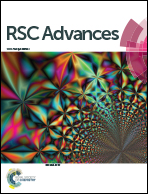Hybrid Mn3O4–NiO nanocomposites as efficient photoelectrocatalysts towards water splitting under neutral pH conditions†
Abstract
Mimicking photosynthesis, water splitting has been adopted as the key step for solar energy conversion. As this route is thermodynamically unfavourable (H = 572 KJ mol−1) and is interesting from a kinetic point of view, the development of cheap and efficient catalysts is a subject of fundamental importance to overcome the clean energy demands of the modern world. In this work, dual oxide nanocomposites consisting of manganese oxide (Mn3O4) and nickel oxide (NiO) have been synthesised for electrochemical water oxidation reaction in the presence of sunlight and ultraviolet light under neutral pH conditions. Kinetic parameters of the electrocatalytic oxygen evolution reaction have been extracted from Tafel plots and faradic efficiency calculations. Our results show that these nanocomposites could catalyse water oxidation in neutral phosphate buffer saline (pH ∼ 7.0) with a current density of 2.2 mA cm−2 and turnover frequency of 4.3 s−1 and in the presence of UV light with 4.5 mA cm−2 and 5.1 s−1 at an applied overpotential of just 280 mV. The significant aspects of this approach include the use of earth-abundant nickel and manganese precursors, facile preparation of the electrocatalysts, the low overpotential and the extremely high turnover frequency for O2 evolution in neutral aqueous media.


 Please wait while we load your content...
Please wait while we load your content...